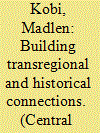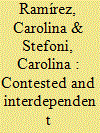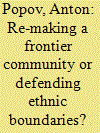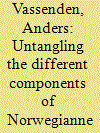| Srl | Item |
| 1 |
ID:
159256


|
|
|
|
|
| Summary/Abstract |
Economic investment and the growing immigration of Han Chinese from other parts of China to the Xinjiang Uyghur Autonomous Region over the last three decades have increased the presence of eastern Chinese architecture in the urban built environment. This paper refers to the making of, residing in and speaking about the materiality of urban architecture by Turkic-speaking Muslim Uyghur middle-class actors. Besides creating personal comfort through Uyghur elements they draw ethnic boundaries to the Han Chinese. In highlighting the materiality of architecture, the analysis expands beyond the individual house by investigating the ways in which urban architecture offers spaces of meaning for social and ethnic communities. Based on ethnographic data, this paper argues that due to the political context and the state-controlled urban development with Chinese characteristics, urban Uyghur architecture was relegated from the outside of houses to an emphasis on interior decoration.
|
|
|
|
|
|
|
|
|
|
|
|
|
|
|
|
| 2 |
ID:
177973


|
|
|
|
|
| Summary/Abstract |
This article examines experiences of making, inhabiting and appropriating space, in relation to the transformations of the political economy in an increasingly multicultural urban setting. Through processes of social production and construction of space, it explores the material, societal and symbolic processes at play. The entry points are memories, images, uses and material connection to Patronato neighbourhood (Santiago, Chile) by people of Korean and Palestinian ancestry. It analyses how claims of space authenticity, processes of ethnicisation and material appropriation of space – commonly understood as given by ‘cultural differences’ – respond to historical, economic and political shifts happening at a global and local level. Moreover, challenging the prism of socioeconomic conflict and separation, it shows emerging dynamics of social interdependence and adjustment, taking place alongside the reorganisation of ethnic boundaries. Such reorganisation allows settled migrants to develop a sense of belonging and control over space in a rapidly changing neoliberal city.
|
|
|
|
|
|
|
|
|
|
|
|
|
|
|
|
| 3 |
ID:
116314


|
|
|
|
|
| Publication |
2012.
|
| Summary/Abstract |
The essay focuses on the notion of the Caucasus as a reference point in the construction of Cossack identity in southern Russia. Since the late Soviet period, the Cossack revivalist/nativist movement has emerged in the territories which constituted the frontier zones of Tsarist Russia. Arguably, the historical Cossack hosts were established as a kind of frontier community which played an important role in the expansion of the Russian Empire. This essay examines how post-Soviet Cossacks reinterpret the meanings of the Caucasus as a spatial and cultural realm where, or in relation to which, they produce their identity as a distinct ethnic and cultural community.
|
|
|
|
|
|
|
|
|
|
|
|
|
|
|
|
| 4 |
ID:
099847


|
|
|
|
|
| Publication |
2010.
|
| Summary/Abstract |
National identity is under scrutiny in Europe. A new non-ethnic conception of the nation to replace the traditional ethnic one is needed. National identity is therefore undergoing a public reconstruction. This article is based on narratives of "Norwegianness" that emerged in a qualitative interview study of white majority Norwegians who live in multicultural suburbs in Oslo. I respond to an overlooked need to analytically untangle different components of "Norwegianness" as phenomenological knowledge, to decouple its different constituents from each other. In order to analyse qualitative data where notions of "Norwegianness" and "non-Norwegianness" are at play, their different aspects must be clarified. I identify multiple discursive oppositions that researchers ought to keep apart, and distinguish between civic aspects (citizenship), cultural aspects, and ethnic/racial aspects. I suggest that everyday notions of the national are fruitfully studied as discursive space constituted by a series of overlapping, but sometimes mutually contradicting, oppositions.
|
|
|
|
|
|
|
|
|
|
|
|
|
|
|
|